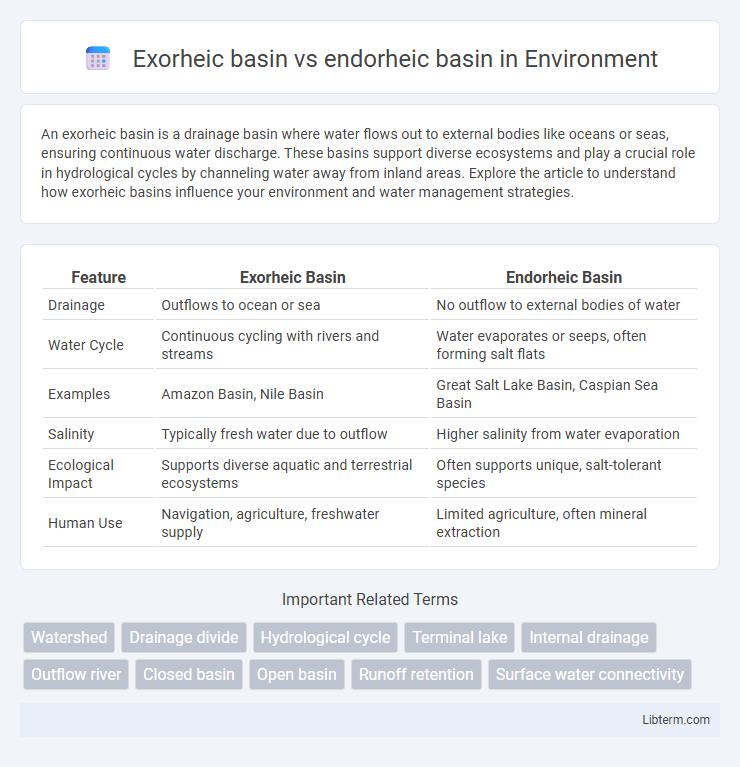An exorheic basin is a drainage basin where water flows out to external bodies like oceans or seas, ensuring continuous water discharge. These basins support diverse ecosystems and play a crucial role in hydrological cycles by channeling water away from inland areas. Explore the article to understand how exorheic basins influence your environment and water management strategies.
Table of Comparison
| Feature | Exorheic Basin | Endorheic Basin |
|---|---|---|
| Drainage | Outflows to ocean or sea | No outflow to external bodies of water |
| Water Cycle | Continuous cycling with rivers and streams | Water evaporates or seeps, often forming salt flats |
| Examples | Amazon Basin, Nile Basin | Great Salt Lake Basin, Caspian Sea Basin |
| Salinity | Typically fresh water due to outflow | Higher salinity from water evaporation |
| Ecological Impact | Supports diverse aquatic and terrestrial ecosystems | Often supports unique, salt-tolerant species |
| Human Use | Navigation, agriculture, freshwater supply | Limited agriculture, often mineral extraction |
Introduction to Exorheic and Endorheic Basins
Exorheic basins are drainage basins where river systems flow outward toward the ocean or sea, facilitating continuous water discharge. Endorheic basins, in contrast, are closed drainage systems with no external outflow, causing water to accumulate and evaporate within the basin. These distinctions influence regional hydrology, climate patterns, and ecosystem development across various geographic landscapes.
Defining Exorheic Basins
Exorheic basins are drainage areas where surface water flows outward toward the ocean or a sea, forming well-defined river systems and deltas. These basins facilitate continuous water discharge, supporting extensive ecosystems and sediment transport to marine environments. Contrarily, endorheic basins retain water internally, leading to evaporation or infiltration without reaching external bodies of water.
Defining Endorheic Basins
Endorheic basins are closed drainage basins that retain water without outflow to external bodies such as rivers or oceans, causing water to evaporate or seep into the ground. These basins are typically characterized by internal drainage, often leading to the formation of salt lakes or playas due to mineral accumulation. Unlike exorheic basins, which drain outward to sea level, endorheic basins occur in arid or semi-arid regions with limited precipitation and high evaporation rates.
Key Differences Between Exorheic and Endorheic Basins
Exorheic basins have outward drainage systems where water flows into oceans or seas, supporting dynamic ecosystems and sediment transport. In contrast, endorheic basins are closed drainage systems with no outlet to external bodies of water, causing water to evaporate or infiltrate locally, often leading to saline or alkaline lakes. The key difference lies in water discharge patterns--exorheic basins facilitate continuous drainage while endorheic basins trap water internally, influencing regional hydrology and soil salinity.
Global Distribution of Exorheic and Endorheic Basins
Exorheic basins, characterized by outward drainage to oceans or seas, dominate approximately 83% of the Earth's land surface and are prevalent in regions such as North America, Europe, and eastern Asia. Endorheic basins, which retain water with no outlet to external bodies, cover about 17% of the land area and are commonly found in arid and semi-arid zones including Central Asia, the Middle East, and parts of Africa's Sahara Desert. The spatial distribution of these basins influences regional hydrology, climate patterns, and ecosystem dynamics across continents.
Hydrological Characteristics and Water Flow
Exorheic basins feature outward-flowing rivers that discharge into oceans or seas, facilitating continuous water exchange and sediment transport. In contrast, endorheic basins lack external drainage, causing water to accumulate in inland lakes or evaporate, leading to higher salinity and limited outflow. These hydrological characteristics influence ecosystem dynamics, water availability, and sediment deposition patterns within each basin type.
Ecological Impacts of Basin Types
Exorheic basins, which drain into external bodies of water like oceans or seas, support diverse aquatic ecosystems and promote nutrient cycling due to continuous water flow and sediment transport. Endorheic basins, characterized by internal drainage with no outlet, often result in hypersaline lakes and concentrated pollutants, leading to unique but fragile ecosystems sensitive to climate fluctuations and human activities. The contrasting hydrological dynamics of these basin types significantly influence regional biodiversity, water quality, and habitat stability.
Human Activities and Basin Management
Exorheic basins, where rivers drain into the ocean, support extensive human activities such as agriculture, urban development, and hydropower due to reliable water outflow and nutrient cycling. Endorheic basins, characterized by internal drainage and no ocean outlet, require specialized basin management focused on water conservation, salinity control, and mitigation of pollution from limited inflow and high evaporation rates. Effective management strategies for both basin types incorporate sustainable water use, pollution control, and ecosystem preservation to address unique hydrological challenges.
Famous Examples of Exorheic and Endorheic Basins
The Amazon Basin stands as a prominent example of an exorheic basin, draining into the Atlantic Ocean through the Amazon River, while the Caspian Sea Basin exemplifies an endorheic basin with no outflow, retaining water in a closed inland sea. The Nile Basin is another key exorheic system, channeling water northward to the Mediterranean, whereas the Great Salt Lake Basin in Utah represents a significant endorheic basin that evaporates water internally. These basins highlight the contrasting hydrological patterns defining global river systems and closed inland water bodies.
Significance in Climate and Environmental Studies
Exorheic basins, which drain water into oceans or seas, play a crucial role in regulating global hydrological cycles and supporting biodiversity by maintaining continuous water flow and nutrient transport. Endorheic basins, characterized by internal drainage with no outflow to external bodies, provide unique environments for studying climate change impacts, water balance, and salinity fluctuations due to their isolated water systems. Understanding the contrasting hydrological behaviors of exorheic and endorheic basins enhances climate models and informs water resource management strategies in arid and semi-arid regions.
Exorheic basin Infographic

 libterm.com
libterm.com